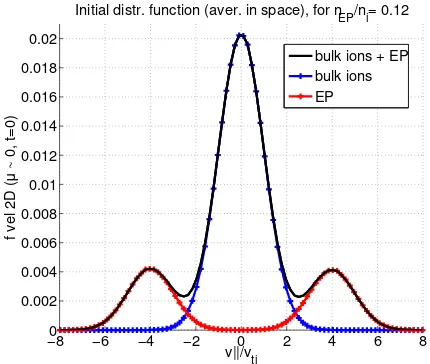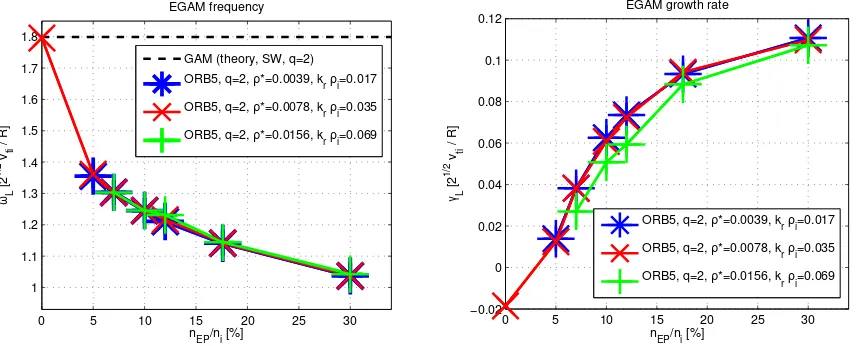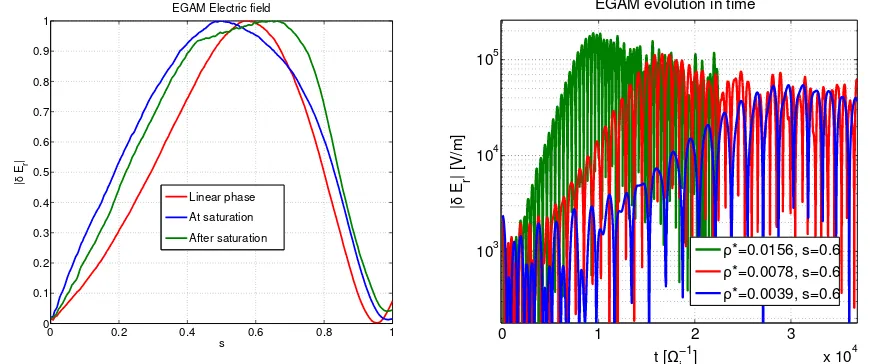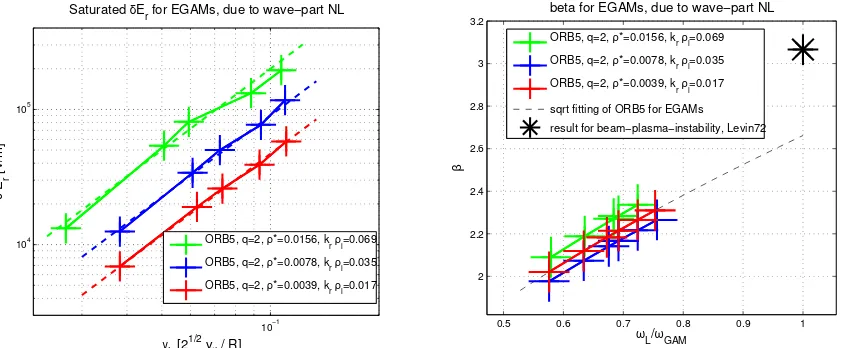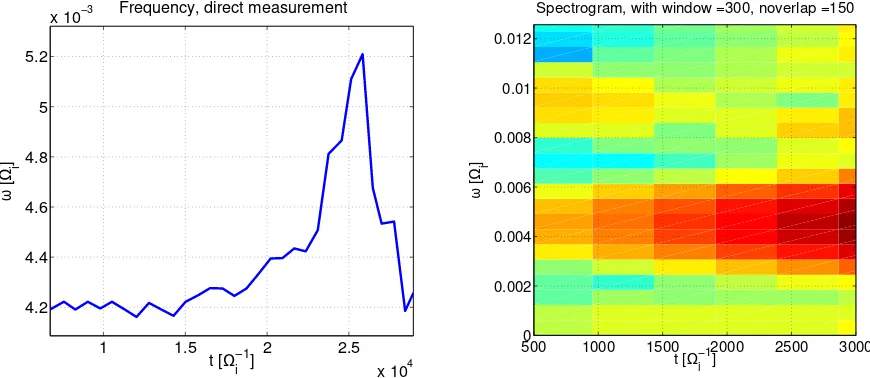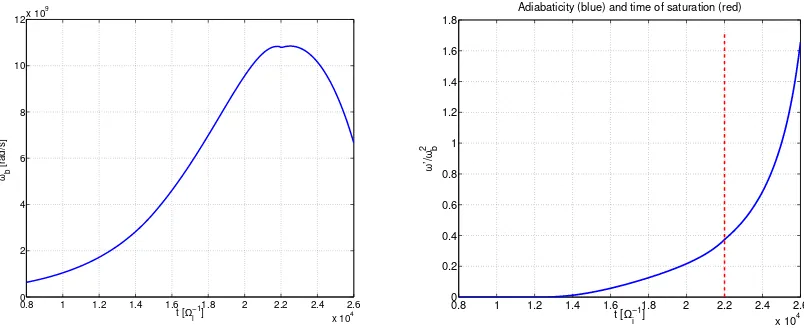arXiv:1709.05998v1 [physics.plasm-ph] 18 Sep 2017
Saturation of energetic-particle-driven geodesic acoustic modes due to wave-particle nonlinearity
Max-Planck Institute for Plasma Physics, 85748 Garching, Germany 2
Institute for Fusion Theory and Simulation and Department of Physics, Zhejiang University, 310027 Hangzhou, People’s Republic of China
3
Institut Jean Lamour- UMR 7198, University of Lorraine, BP 239 F-54506 Vandoeuvre les Nancy, France
4
LPP, CNRS, `Ecole polytechnique, UPMC Univ Paris 06, Univ. Paris-Sud, Observatoire de Paris, Universit´e Paris-Saclay, Sorbonne Universit´es, PSL Research University, 91128 Palaiseau, France
contact of main author: www2.ipp.mpg.de/~biancala
Abstract
The nonlinear dynamics of energetic-particle (EP) driven geodesic acoustic modes (EGAM) is investigated here. A numerical analysis with the global gyrokinetic particle-in-cell code ORB5 is performed, and the results are interpreted with the analytical theory, in close com-parison with the theory of the beam-plasma instability. Only axisymmetric modes are consid-ered, with a nonlinear dynamics determined by wave-particle interaction. Quadratic scalings of the saturated electric field with respect to the linear growth rate are found for the case of interest. The EP bounce frequency is calculated as a function of the EGAM frequency, and shown not to depend on the value of the bulk temperature. Near the saturation, we observe a transition from adiabatic to non-adiabatic dynamics, i.e., the frequency chirping rate becomes comparable to the resonant EP bounce frequency. The numerical analysis is performed here with electrostatic simulations with circular flux surfaces, and kinetic effects of the electrons are neglected.
1
Introduction
Two main issues related to magnetic confinement fusion are the turbulent transport, and the dy-namics of energetic particles (EP), produced by fusion reactions, or injected for heating purposes. Zonal (i.e. axisymmetric) electric fields are observed to interact with turbulence in tokamaks, in the form of zero-frequency zonal flows (ZF) [1, 2, 3] and finite-frequency geodesic acoustic modes (GAM) [4, 5]. Geodesic acoustic modes, due to their finite frequency, can also interact with EP via inverse Landau damping, leading to EP-driven GAM (EGAM) given that EP drive is sufficient to overcome the threshold condition induced by GAM Landau damping and continuum damping [6, 7, 8, 9, 10, 11, 12]. Understanding the dynamics of EGAMs is crucial due to their in-teraction with turbulence, which can modify the turbulent transport [13, 14]. Moreover, a strong nonlinear interaction of EGAM with EP is observed in tokamaks [15, 16], leading potentially to a strong redistribution of the EP in phase space.
paper, we focus on the wave-particle nonlinear interactions. For an investigation of the EGAM self-coupling, see Ref. [17].
The nonlinear saturation of EGAMs is investigated here by means of electrostatic simulations with the gyrokinetic particle-in-cell code ORB5 [18, 19, 20]. ORB5 has been succesfully verified against analytical theory and benchmarked against other gyrokinetic codes, for the linear dynam-ics of GAMs [21], and EGAMs [22, 23]. A detailed comparison with the beam-plasma instability (BPI) [24, 25] in a 1-dimensional uniform plasma is also done, following the scheme anticipated in Ref. [8, 26]. Similarly to the BPI, the saturation level of EGAM is shown to scale quadratically with the linear growth rate. A similar investigation was also previously done for Alfv´en modes (see, for example, Ref. [27]). The EGAM frequency is shown to evolve in time when approaching the saturation, like the BPI (see, for example, Ref. [28, 29]). The chirping rate is observed to get of the order of magnitude of the squared of the EP bounce frequency near the saturation. This denotes a transition from adiabatic to non-adiabatic regimes.
The paper is organized as follows. The adopted gyrokinetic model is described in Sec. 2, and the equilibrium and case definition in Sec. 3. The linear dynamics is described in Sec. 4. The saturation levels are investigated in Sec. 5. The regimes of different adiabaticity are investigated by means of the analysis of the frequency, in Sec. 6. Finally, a summary of the results is given in Sec. 7.
2
The model
The main damping mechanism of GAM and EGAM is the Landau damping, which makes the use of a kinetic model necessary. In this paper we use the global gyrokinetic particle-in-cell code ORB5 [18]. ORB5 was originally developed for electrostatic ITG turbulence studies, and recently extended to its multi-species electromagnetic version in the framework of the NEMORB project [19, 20]. In this paper, collisionless electrostatic simulations are considered.
The model equations of the electrostatic version of ORB5 is made by the trajectories of the markers, and by the gyrokinetic Poisson law for the scalar potentialφ. These equations are derived in a Lagrangian formulation [20], based on the gyrokinetic Vlasov-Maxwell equations of Sugama, Brizard and Hahm [32, 33]. The equations for the marker trajectories (in the electrostatic version of the code) are [20]:
Kinetic effects of the electrons are neglected. This is done by calculating the electron gyro-center density directly from the value of the scalar potential as [20]:
ne(R, t) =ne0+
qsne0
Te0
φ−φ¯
(4)
where ¯φ is the flux-surface averaged potential, instead of treating the electrons with markers evolved with Eqs. 1, 2, 3.
We focus on the dynamics of zonal perturbations, by filtering out all non-zonal components (this is to avoid interactions of zonal/non-zonal modes). Wave-wave coupling is neglected, by evolving the bulk-ion and electron markers along unperturbed trajectories. This means that, in Eqs. 1, 2, 3 for the bulk ions, the last terms, proportional to the EGAM electric field, are dropped. The nonlinear wave-particle dynamics is studied by evolving the EP markers along the trajectories which include perturbed terms associated with the EGAM electric field. This means that the EP markers are evolved with Eqs. 1, 2, 3 where the terms proportional to the EGAM electric field are retained.
The gyrokinetic Poisson equation is [20]:
−∇ ·n0mic
withn0mi being here the total plasma mass density (approximated as the ion mass density). The summation over the species is performed for the bulk ions and for the EP, whereas the electron contribution is given by −ne(R, t). Here δf = f −f0 is the gyrocenter perturbed distribution function, withf and f0 being the total and equilibrium (i.e. independent of time, assumed here to be a Maxwellian) gyrocenter distribution functions. The integrals are over the phase space volume, with dW = (2π/m2
i)Bk∗dpkdµbeing the velocity-space infinitesimal volume element.
3
Equilibrium and simulation parameters
The tokamak magnetic equilibrium is defined by a major and minor radii of R0 = 1 m and
a = 0.3125 m, a magnetic field on axis of B0 = 1.9 T, a flat safety factor radial profile, with
q = 2, and circular flux surfaces (with no Grad-Shafranov shift). Flat temperature and density profiles are considered at the equilibrium. The bulk plasma temperature is defined byρ∗=ρ
s/a, withρs=cs/Ωi, withcs=
p
Te/mi being the sound speed and Ωi the cyclotron frequency. Three increasing values of bulk plasma temperature are considered, for investigating the dependence of our results on the Landau damping, corresponding to: ρ∗
1 = 1/256 = 0.0039,ρ∗2 = 1/128 = 0.0078, and ρ∗3 = 1/64 = 0.0156 (τe =Te/Ti= 1 for all cases described in this paper).
−80 −6 −4 −2 0 2 4 6 8 0.002
0.004 0.006 0.008 0.01 0.012 0.014 0.016 0.018 0.02
v||/vti
f vel 2D (
µ
∼
0, t=0)
Initial distr. function (aver. in space), for nEP/ni= 0.12 bulk ions + EP bulk ions EP
Figure 1: Initial EP distribution function for a simulation with nEP/ni= 0.12, vbump/vti = 4.
following three values of the sound frequency: ωs1= 3.14·105 rad/s,ωs2 = 6.28·105 rad/s, and
ωs3= 1.25·106 rad/s.
The energetic particle distribution function is a double bump-on-tail, with two bumps at
vk = ±vbump (see Fig. 1), like in Ref. [22]. In this paper, vbump = 4vti is chosen. In order to initialize a distribution function which is function of constants of motion only, the modified variable ˜vk =p
2(E−µBmax)/m/vti is used instead ofvk =p2(E−µB(r, θ))/m/vti (similarly
to Ref. [10, 22, 23]). Neumann and Dirichlet boundary conditions are imposed to the scalar potential, respectively at the inner and outer boundaries, s= 0 and s= 1.
4
Linear dynamics
The linear dynamics of EGAMs in an equilibrium similar to the one considered in Sec. 3, has been investigated in Ref. [23] for a bulk plasma temperature given by ρ∗ = 1/64 = 0.0156, by means of ORB5 simulations and analytical theory. A scan on the EP concentration is performed here, similarly to what was done in Ref. [23], but with three different values of bulk plasma temperature, corresponding to three different values of ρ∗, as described in Sec. 3. The dependence of the linear dynamics (frequency and growth rate) on the EP concentration is shown in Fig. 2. Both the frequency and the growth rates are observed to follow the qualitative scalings as described in Ref. [22] and [23]. Note, in particular, that the growth rate does not grow linearly with nEP.
The dependence of the frequency on the EP concentration is not observed to change withρ∗. Regarding the growth rate, no change is observed when going from ρ∗3 = 0.0039 to ρ∗2 = 0.0078, meaning that the measured growth rate is basically given by the value of the drive, and the Landau damping here is negligible for the chosen values of EP concentration. On the other hand, when further increasing the temperature, and going toρ∗1 = 0.0156, a smaller value of growth rate is measured, meaning a higher Landau damping. The transit resonance velocity of the EP can be calculated by knowing the EGAM frequency of a specific simulation. Considering a case with
0 5 10 15 20 25 30
Figure 2: Frequency (left) and growth rate (right) vs EP concentration, for simulations with ¯
ζ =vbump/vth=4.
GAM frequency for these parameters is ωGAM = 1.8ωs. Then, the transit resonance velocity in the linear phase is calculated asvk0 =qR ωL= 3.4vti, withωLbeing the EGAM linear frequency.
5
Scaling of the saturated amplitudes
In this Section, we focus on the value of the saturated electric field δE¯r, and we investigate its dependence on the value of the linear growth rate and of the damping. The corresponding scaling of ¯δEr sheds light on the mechanism which is responsible for the saturation. A one-to-one comparison with the saturation mechanism of the BPI is also described.
The amplitude of the EGAM at saturation has been measured in different simulations per-formed with ORB5, for different values of the bulk temperature, and different values of the EP concentrations. As an example, the radial structure of a nonlinear simulation with ρ∗ = 0.0156,
nEP/ni= 0.176 is depicted in Fig. 3-a. No sensible change in the radial wave-number is observed when going from the linear phase, to the saturation, and after the saturation. This confirms that in this particular configuration, where all equilibrium radial profiles are flat, EGAM can be treated as a 1-dimensional problem where the radial direction does not play an important role.
When varying only the bulk temperature, both the linear frequency and growth rate are ob-served to scale with the sound frequency, which is a good normalization frequency (consistently with Fig. 2). The saturation level increases with the linear growth rate, similarly to other insta-bilities like the BPI in a uniform system and the Alfv´en instainsta-bilities in tokamaks. This is depicted in Fig. 3-b, where non-normalized units are used (in particular, the ion cyclotron frequency is selected as a time unit not depending on the temperature).
The scalings with the energetic particle concentration are also investigated. The results are shown in Fig. 4a. We obtain that, in the considered regime, the saturated level scales as the quadratic power of the linear growth rate. This quadratic scaling is typical for marginally stable bump-on-tail instabilities, as derived by O’Neil [24, 25].
particles are moving in the potential well of the perturbed electric field. Depending on the energy, some particles are trapped inside the well and execute bounce motion with frequency ωb in the frame moving with the wave phase velocity. The resonant particles exchange energy with the mode, causing the amplitude to grow and the particles to redistribute in phase space, flattening the velocity distribution in the vicinity of the resonant parallel velocity vk =ωqR0. The drive is due to the positive slope of the particle distribution in the velocity space at the resonant parallel velocity, which acts as an inverse Landau damping. In the initial stage ωb ≪γL, the mode grows exponentially with a linear growth rate, making more and more particles to become trapped in the phase space. After some significant particle velocity redistribution, the power exchange between the wave and the particles is balanced, causing the wave amplitude to saturate.
Since the initial perturbation is negligible, the saturation level is determined by the exchange of energy between the mode and a band of resonant particles [30]. The chirping of the mode seen in Fig. 5 is a strongly non-linear effect that occurs when the amplitude is large enough to have the trapped (and more generally resonant) particles with ωb ∼ γL drastically change the dynamics of the mode through the modification of the distribution function and non-perturbative fast particle response. Namely, the mode dynamics is determined by all resonant particles that exhibit a continuous oscillation, trapping and detrapping in the potential well of the mode, thus contributing (non-perturbatively) to the non-adiabatic behavior observed in the simulation.
The quadratic scaling of the saturation level with the damping obtained with our simulations is similar to the saturation of the BPI, where it occurs due to wave-particle trapping [24]. For the BPI, the original reference of M. B. Levin (1972) gives a value of ωb = 3.06γL at saturation [30] (for comparison, note that more recent numerical calculations find ωb = 3.2γL [34, 35]). For
0 0.2 0.4 0.6 0.8 1 the right, absolute value of the electric field measured at the position of the peak, s = 0.6, for three different simulations with respectively ρ∗ = 0.0039 (blue), ρ∗ = 0.0078 (red), ρ∗ = 0.0156 (green). All simulations here have nEP/ni = 0.30. The time is expressed in units of Ω−
1
10−1
beta for EGAMs, due to wave−part NL
ORB5, q=2, ρ*=0.0156, k
sqrt fitting of ORB5 for EGAMs result for beam−plasma−instability, Levin72
Figure 4: On the left, maximum value of the EGAM radial electric field, vs linear growth rate, for the same simulations as in Fig. 2. The red, blue and green crosses refer respectively to
ρ∗ = 0.0039, ρ∗ = 0.0078, ρ∗ = 0.0156. The dashed lines are the quadratic fitting formulas. On the right, the value of β as given in Eq. 10, vs the linear frequency, for the same simulations. The black dashed line is the sqruare root interpolation. For a reference, the black star shows the result obtained for the BPI in Ref. [30].
EGAMs, the bounce frequency is given by [8]:
ω2b =α1δE¯r, withα1 ≡
eVˆdc 2mEPvk0qR0
(6)
with mEP being the mass of the energetic particle specie, considered equal to the bulk ion mass in this paper, vk0 the velocity matching the resonance condition, and ˆVdc =mEPv
2
k0/(eBR) the magnetic curvature drift. Therefore we have:
α1=
vk0 2qR2B =
ωL
2RB (7)
We emphasize that the value of α1 depends onωL. This is a main difference with respect to the BPI, where there is only one value ωlin=ωpe, withωpe being the plasma frequency.
The dependence of the maximum electric field on the linear growth rate can be measured with the results of the numerical simulations. For the simulations shown in Fig. 4, we find:
¯
δEr=α2γ 2
L (8)
The values of α2 are found to depend on the bulk temperature. For the three chosen increasing values of ρ∗, i.e. ρ∗ = 0.0039, 0.0078 and 0.0156, we have respectively α2 = 0.47 ·107 V/m, 0.9·107 V/m, and 2.0·107 V/m. Finally the relationship between the EP bounce frequency and
the linear growth rate is obtained:
where β is calculated as β = (α1α2)1/2/ωs, which yields:
β=β0
ωL
ωGAM
1/2
, with β0 = 1
ωs
ωGAMα2
2RB 1/2
(10)
Note that here,β depends on the EGAM frequency, which changes with the intensity of the drive, given here by the EP concentration (see Fig. 2). As a comparison, note that in the problem of the BPI, solved in Ref. [24, 25, 30], on the other hand, the mode frequency is assumed to be constant and equal to the frequency measured in the absence of EP. On the other hand, the values ofβ are found not to depend on the damping, which changes with the three different bulk temperatures: an interpolation can be drawn for all considered simulations, and shown to depend on ωL only (see Fig. 4b). In this sense, the formula given in Eq. 10 is universal for the chosen regime, because it does not depend on the bulk plasma temperature.
The considered equilibrium has been chosen in order to excite EGAMs out of a GAM, and not out of a Landau pole, as described in Ref. [23]. This choice of the mode is done, in order to have a one-to-one correspondence with the BPI, where the mode which is excited by the energetic electron beam is the Langmuir wave which is an eigenmode of the system in the absence of EP. Following this consideration, we can consider the interpolation of the results shown in Fig. 4, and take the extrapolation to ωL→ ωGAM, which is the limit assumed in the resolution of the BPI. In this case, the extrapolation gives a unique value, which defines the EGAM instability, i.e. β0 =β(ωL/ωGAM = 1) = 2.66. This is to be compared with the value of β obtained for the BPI [30, 34, 35], i.e. βBP I = 3.2 (originally estimated asβBP I = 3.06 by Levin).
Finally, by using Eqs. 6, 7, 9 and 10, we can write the formula for the saturated electric field as a function of the linear characteristics of the mode:
δEr=
2RBβ2 0
ωGAM
γ2
L (11)
with the value of β0 = 2.66 in the regime considered in this paper.
6
Frequency
In this section, we show the results of the measurement of the time evolution of the EGAM frequency. In Sec. 5, we have shown that a quadratic scaling of the saturated electric field on the linear growth rate is found. This quadratic scaling, has a one-to-one correspondence on the Langmuir wave problem investigated by O’Neil, where the saturation occurs due to wave-particle trapping. The wave-particle trapping mechanism, is usually referred to as adiabatic, meaning that a slowly increasing potential well traps more and more energetic particles. In this adiabatic regime, the mode frequency varies very slowly with respect to the bounce frequency. On the other hand, in the EGAM case considered here, we show that the saturation is not strictly adiabatic, but a transition between adiabatic and non-adiabatic regime occurs at the time of the saturation.
In this section, we take again the EGAM case withρ∗ = 0.0078, n
1 1.5 2 2.5
Frequency, direct measurement Spectrogram, with window =300, noverlap =150
t [Ωi−1]
ω
[
Ωi
]
5000 1000 1500 2000 2500 3000 0.002
Figure 5: Nonlinear evolution of the frequency, measured as a short-time average of the period between the peaks (left) or with a short-time Fourier transform (right), forρ∗ = 0.0078,n
EP/ni= 0.12.
With the first technique, namely measuring the frequency by inversion of the period between neighbouring peaks, an upward chirping is observed in the nonlinear phase, of the order of 10% of the linear frequency. This means that the resonance condition changes in time, with resonance velocity slightly increasing at the time of the saturation or in the later phase (see Fig. 5-a). A dominantly upward chirping of EGAMs was previously observed and documented in Ref. [36, 11]. The second technique, consists in measuring the frequency with a short-time Fourier transform (STFT) on a Hamming time-window. With this technique, the error bar in frequency is large (due to the small number of oscillations in the nonlinear regime around the saturation), namely of the order of 10-20% (see Fig. 5-b). With such a big error-bar, no clear upward chirping is observed. Near the time of the saturation, i.e. t≃2.2 Ω−1
i , only one mode is observed. This is the condition of application of the direct technique of measurement of the frequency described above, where the frequency can be measured as the inverse of the period among peaks.
As mentioned above, the EP bounce frequency ωb depends on the mode amplitude. Its value for the considered simulation is shown in Fig. 6-a. When the EGAM frequency evolves slowly in time with respect to the inverse of the bounce frequency, then the EP can bounce back and forth many times, and this is called adiabatic dynamics. The adiabaticity parameter, defined as ω′/ω2
0.8 1 1.2 1.4 1.6 1.8 2 2.2 2.4 2.6
Adiabaticity (blue) and time of saturation (red)
t [Ωi−1
Figure 6: Squared bounce frequency (left) and adiabaticity (right) for the EGAM with ρ∗ = 0.0078, nEP/ni = 0.12.
7
Summary and discussion
The importance of understanding the nonlinear dynamics of EGAM, i.e. energetic particle (EP) driven geodesic acoustic modes (GAM), is due to their possible role in interacting with turbulence and with the EP population present in tokamak plasmas as a result of nuclear reactions and/or heating mechanisms. In particular, the level of the nonlinear saturation of EGAM is directly related to their efficiency in regulating turbulence or redistributing EP in phase space.
In this paper, we have investigated the problem of the nonlinear saturation of EGAM with the gyrokinetic particle-in-cell code ORB5, focusing on the wave-particle nonlinearity. Electrostatic collisionless simulations have been considered, with circular flux surfaces magnetic equilibria, and neglecting the kinetic effects of electrons.
The level of the saturated electric field has been shown to scale quadratically with the lin-ear growth rate, similarly to the beam-plasma instability (BPI) in 1D uniform plasmas, and to Alfv´en Eigenmodes (AE) near marginal stability. We note that, in the case of beta-induced AE, due to the finite radial mode structure compared to resonant particle radial excursion, deviation from the δEr ∝γL2 is observed due to the competition of resonance detuning and radial decou-pling [37, 38]. A similar deviation is anticipated as one further increases the drive of EPs, from the correspondence of EP pitch angle scattering by frequency chirping EGAMs and the radial wave-particle pumping by frequency chirping finite-n BAEs. This will be the content of our next publication.
We have also investigated the relationship of the bounce frequency of the EP in the field of the EGAM, with the linear growth rate, finding a linear dependence, similarly to the BPI. The linear coefficient, in the case of the EGAM problem, is proportional to the square root of the EGAM frequency, and is not a constant like in the beam-plamsa instability. In the limit of
ωL/ωGAM →1, which corresponds to the BPI problem when the mode frequency does not move sensibly from the value of the plasma frequency ωp, a unique value of the linear coefficient can be estimated: β0 = 2.66, to be compared with the factor βBP I ≃3.2 of the BPI. This value of
on equilibrium parameters like the safety factor q, the magnetic flux surface elongatione, the EP distribution function, and the effect of kinetic electrons is left to a future work.
Finally, we have investigated the temporal variation of the EGAM frequency during the saturation phase. The initial adiabatic regime, defined as the regime where the time derivative of the EGAM frequency is much smaller than the squared EP bounce frequency, has been shown to have a transition to a non-adiabatic regime at the saturation. The exact analytical model of this phenomenon is still a work in progress and will be the first expansion of this work. The simplified picture is that the mode will chirp to maintain maximal exchange of power with the energetic particles [39], while balancing the Landau damping. The mode frequency is at the same time bound by the wave dispersion relation and plasma equilibrium, making their simultaneous examination with the power exchange equation necessary for determining the rate and direction of chirping. The non-adiabatic behavior is enabled by the non-perturbative response of the energetic particles, which consists of significant distortion of the distribution function in the resonant region, as well as of the particle trapping and detrapping [39]. Differently, the adiabatic chirping is connected with either external driven fluctuations, or slow energetic particle redistribution, provided that the drive is sufficiently weak [40].
Acknowledgements
Interesting discussions with N. Carlevaro, G. Montani, F. Zonca on the nonlinear dynamics of the energetic particles are acknowledged. Interesting discussions with A. Mishchenko and B. Finney McMillan on the treatment of EGAMs with ORB5 are also acknowledged. Part of this work has been carried out within the framework of the EUROfusion Consortium and has received funding from the Euratom research and training programme 2014-2018 under grant agreement No 633053, within the framework of the Nonlinear energetic particle dynamics (NLED) Euro-pean Enabling Research Project, WP 15-ER-01/ENEA-03. The views and opinions expressed herein do not necessarily reflect those of the European Commission. Part of this work has been funded by the Centre de Coop´eration Universitaire Franco-Bavarois - Bayerisch-Franz¨osisches Hochschulzentrum, for the grant FK 30 15. Simulations were performed on the Marconi super-computer within the framework of the OrbZONE and ORBFAST projects. Part of this work was done while two of the authors (A. Biancalani and I. Novikau) were visiting LPP-Palaiseau, whose team is acknowledged for the hospitality. One of the authors (I.C.) wants to thank the Max Planck Princeton Center for the support during this work.
References
[1] A. Hasegawa, C. G. Maclennan, and Y. Kodama, Phys. Fluids22, 2122 (1979)
[2] M.N. Rosenbluth and F.L. Hinton, Phys. Rev. Lett. 80,4 724 (1998)
[3] P.H. Diamond, S.-I. Itoh, K. Itoh, and T. S. Hahm, Plasma Phys. Controlled Fusion47, R35 (2005)
[4] N. Winsor, J. L. Johnson, and J. M. Dawson, Phys. Fluids 11, 2448, (1968)
[6] G. Fu et al. Phys. Rev. Lett. 101, 185002 (2008)
[7] Z. Qiu, F. Zonca and L. Chen,Plasma Phys. Controlled Fusion 52, 095003 (2010)
[8] Z. Qiu, F. Zonca, L. Chen Plasma Science and Tech.13, 257 (2011)
[9] Z. Qiu, F. Zonca, L. Chen Phys. Plasmas19082507 (2012)
[10] D. Zarzoso et al. Phys. Plasmas 19, 022102-1 (2012)
[11] H. Wang, Y. Todo and C. C. Kim Phys. Rev. Lett.110, 155006 (2013)
[12] G. B. Girardo, et al. Phys. Plasmas21092507 (2014)
[13] D. Zarzoso et al. Phys. Rev. Lett. 110, 125002 (2013)
[14] D. Zarzoso et al. Nucl. Fusion 57072011 (2017)
[15] P. Lauber, ITPA technical meeting on energetic particles (2014)
[16] L. Horv´ath et al. Nucl. Fusion56112003 (2016)
[17] Z. Qiu, I. Chavdarovski, A. Biancalani, and J. Cao, Phys. Plasmas 24, 072509 (2017)
[18] S. Jolliet, A. Bottino, P. Angelino, R. Hatzky, T. M. Tran, B. F. Mcmillan, O. Sauter, K. Appert, Y. Idomura, and L. Villard, Comput. Phys177, 409 (2007).
[19] A. Bottino, T. Vernay, B. D. Scott, S. Brunner, R. Hatzky, S. Jolliet, B. F. McMillan, T. M. Tran, and L. VillardPlasma Phys. Controlled Fusion53, 124027 (2011)
[20] A. Bottino and E. Sonnendr¨ucker, J. Plasma Phys. 81, 435810501 (2015).
[21] A. Biancalani, A. Bottino, C. Ehrlacher, V. Grandgirard, G. Merlo, I. Novikau, Z. Qiu, E. Sonnendr¨ucker, X. Garbet, T. G¨orler, S. Leerink, F. Palermo, and D. Zarzoso,Phys. Plasmas 24, 062512 (2017)
[22] A. Biancalani, et al. Nucl. Fusion 54, 104004 (2014)
[23] D. Zarzoso, A. Biancalani, A. Bottino, Ph. Lauber, E. Poli, J.-B. Girardo, X. Garbet and R.J. Dumont,Nucl. Fusion 54, 103006 (2014)
[24] T. M. O’Neil Phys. Fluids8, 2255 (1965)
[25] T. M. O’Neil and J. H. MalmbergPhys. Fluids 11, 1754 (1968)
[26] Z. Qiu, L. Chen and F. Zonca 41st EPS Conference on Plasma Physics, P4.004 (2014)
[27] S. Briguglio, X. Wang, F. Zonca, G. Vlad, G. Fogaccia, C. Di Troia and V. Fusco, Phys. Plasmas 21, 112301 (2014).
[28] G. J. Morales and T. M. O’Neil, Phys. Rev. Letters 28, 417 (1972).
[30] M. B. Levin, M. G. Lyubarskii, I. N. Onishchenko, V. D. Shapiro, and V. I. Shevchenko,
Sov. Phys. JETP35, 898 (1972)
[31] G. Fu and J. W. Van Dam, Phys. Fluids B1, 1949 (1989)
[32] H. Sugama, Phys. Plasmas7, 466 (2000)
[33] A. J. Brizard and T. S. Hahm, Rev. Mod. Phys79, 421 (2007)
[34] M. Lesur, Y. Idomura, and X. Garbet,Phys. Plasmas 16, 092305 (2009).
[35] N. Carlevaro, et al, to be submitted (2017)
[36] H.L. Berk, C.J. Boswell, D. Borba, A.C.A. Figueiredo, T. Johnson, M.F.F. Nave, S.D. Pinches, S.E. Sharapov and JET EFDA contributors, Nucl. Fusion46S888-S897 (2006)
[37] X. Wang, S. Briguglio, L. Chen, C. Di Troia, G. Fogaccia, G. Vlad, and F. Zonca Phys. Rev. E86, 045401(R) (2012)
[38] H. S. Zhang, Z. Lin, and I. Holod Phys. Rev. Lett.109, 025001 (2012)
[39] L. Chen and F. Zonca, Rev. Mod. Phys.881, (2016)
[40] B. N. Breizman, H. L. Berk, M. S. Pekker, F. Porcelli, G. V. Stupakov, and K. L. Wong,
